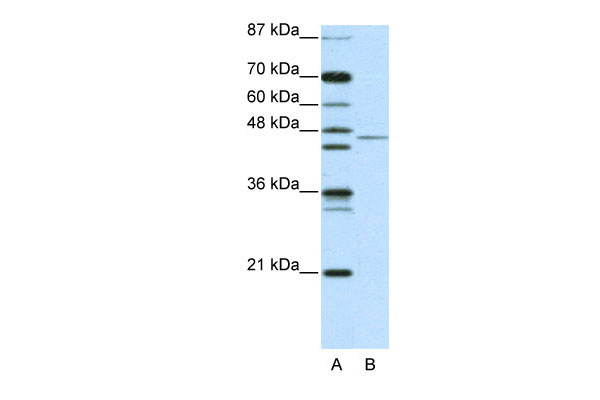TRIM14 antibody - N-terminal region
Rabbit Polyclonal Antibody
- SPECIFICATION
- CITATIONS
- PROTOCOLS
- BACKGROUND

Application
| WB |
|---|---|
| Primary Accession | Q14142 |
| Other Accession | NM_014788, NP_055603 |
| Reactivity | Human, Mouse, Rat, Rabbit, Pig, Horse, Bovine, Dog |
| Predicted | Human, Mouse, Rat, Rabbit, Pig, Horse, Bovine, Dog |
| Host | Rabbit |
| Clonality | Polyclonal |
| Calculated MW | 50kDa |
| Gene ID | 9830 |
|---|---|
| Other Names | Tripartite motif-containing protein 14, TRIM14, KIAA0129 |
| Format | Liquid. Purified antibody supplied in 1x PBS buffer with 0.09% (w/v) sodium azide and 2% sucrose. |
| Reconstitution & Storage | Add 100 ul of distilled water. Final anti-TRIM14 antibody concentration is 1 mg/ml in PBS buffer with 2% sucrose. For longer periods of storage, store at 20°C. Avoid repeat freeze-thaw cycles. |
| Precautions | TRIM14 antibody - N-terminal region is for research use only and not for use in diagnostic or therapeutic procedures. |
| Name | TRIM14 |
|---|---|
| Synonyms | KIAA0129 |
| Function | Plays an essential role in the innate immune defense against viruses and bacteria (PubMed:30150992, PubMed:32404352). Promotes the 'Lys-48'-linked ubiquitination and subsequent degradation of hepatitis C virus NS5A leading to the inhibition of viral replication (PubMed:27578425). Also plays a role in the inhibition of ebolavirus infection by enhancing IFN-beta and NF-kappa-B activation after binding to the viral protein NP (PubMed:37562033). Facilitates the type I IFN response by interacting with MAVS at the outer mitochondria membrane and thereby recruiting NF-kappa-B essential modulator IKBKG/NEMO to the MAVS signalosome, leading to the activation of both the IFN regulatory factor 3/IRF3 and NF-kappa-B pathways (PubMed:24379373). Positively regulates the CGAS-induced type I interferon signaling pathway by stabilizing CGAS and inhibiting its autophagic degradation (PubMed:27666593). Acts as a scaffold between TBK1 and STAT3 to promote phosphorylation of STAT3 and resolve interferon-stimulated gene (ISG) expression (PubMed:32404352). Inhibits the transcriptional activity of SPI1 in a dose-dependent manner (By similarity). Also inhibits OPTN- mediated selective autophagic degradation of KDM4D and thereby negatively regulates H3K9me2 and H3K9me3. Mechanistically, recruits USP14 to remove the 'Lys-63'-linked ubiquitination of KDM4D, preventing its recognition by OPTN and subsequent degradation (PubMed:35145029). |
| Cellular Location | Mitochondrion outer membrane. Cytoplasmic vesicle, phagosome. Nucleus |
| Tissue Location | Highest expression in liver; undetectable in skeletal muscle |

Thousands of laboratories across the world have published research that depended on the performance of antibodies from Abcepta to advance their research. Check out links to articles that cite our products in major peer-reviewed journals, organized by research category.
info@abcepta.com, and receive a free "I Love Antibodies" mug.
Provided below are standard protocols that you may find useful for product applications.
If you have used an Abcepta product and would like to share how it has performed, please click on the "Submit Review" button and provide the requested information. Our staff will examine and post your review and contact you if needed.
If you have any additional inquiries please email technical services at tech@abcepta.com.













 Foundational characteristics of cancer include proliferation, angiogenesis, migration, evasion of apoptosis, and cellular immortality. Find key markers for these cellular processes and antibodies to detect them.
Foundational characteristics of cancer include proliferation, angiogenesis, migration, evasion of apoptosis, and cellular immortality. Find key markers for these cellular processes and antibodies to detect them. The SUMOplot™ Analysis Program predicts and scores sumoylation sites in your protein. SUMOylation is a post-translational modification involved in various cellular processes, such as nuclear-cytosolic transport, transcriptional regulation, apoptosis, protein stability, response to stress, and progression through the cell cycle.
The SUMOplot™ Analysis Program predicts and scores sumoylation sites in your protein. SUMOylation is a post-translational modification involved in various cellular processes, such as nuclear-cytosolic transport, transcriptional regulation, apoptosis, protein stability, response to stress, and progression through the cell cycle. The Autophagy Receptor Motif Plotter predicts and scores autophagy receptor binding sites in your protein. Identifying proteins connected to this pathway is critical to understanding the role of autophagy in physiological as well as pathological processes such as development, differentiation, neurodegenerative diseases, stress, infection, and cancer.
The Autophagy Receptor Motif Plotter predicts and scores autophagy receptor binding sites in your protein. Identifying proteins connected to this pathway is critical to understanding the role of autophagy in physiological as well as pathological processes such as development, differentiation, neurodegenerative diseases, stress, infection, and cancer.


